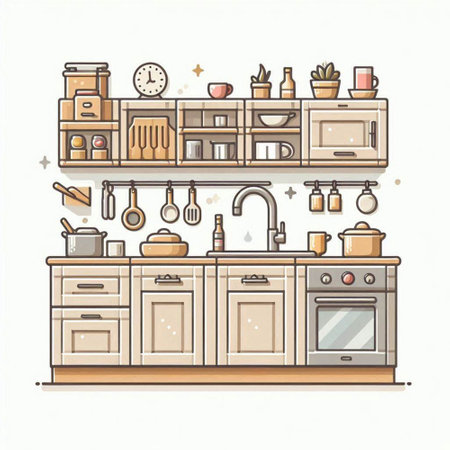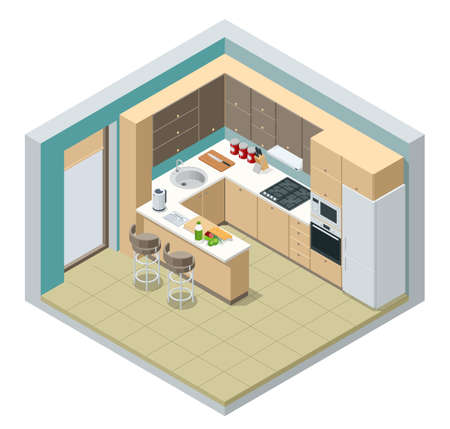1. Understanding the Challenges of Compact British Kitchens
In the United Kingdom, many homeowners face the daily reality of working with compact kitchen spaces, a legacy of traditional building styles and high-density urban living. These kitchens often feature narrow galley layouts or boxed-in corners that limit both natural light and the overall feeling of spaciousness. Older properties, particularly Victorian and Edwardian terraces, frequently come with small windows and thick internal walls, further restricting daylight penetration. As a result, even well-kept kitchens can feel cramped and dim, impacting both their practicality and ambience. Recognising these common spatial constraints is crucial before considering any design improvements. The layout not only dictates how you move within the kitchen but also how effectively light—whether natural or artificial—circulates through the space. By understanding these unique challenges, you can make informed decisions about integrating British light fixtures and mirrors to create a brighter, airier atmosphere in your compact kitchen.
2. Choosing the Right British Light Fixtures for Small Spaces
When it comes to opening up compact UK kitchens, the selection of light fixtures plays a pivotal role. Not only should your lighting choices complement quintessential British design sensibilities, but they must also suit the unique wiring standards and layouts typical of British homes. To achieve both style and practicality, it’s essential to consider ceiling, wall, and under-cabinet lighting options that maximise brightness without overwhelming your limited space.
Ceiling Lighting: Central and Subtle Illumination
Traditional British kitchens often feature central ceiling lights. Opt for flush or semi-flush fittings in classic finishes such as brushed chrome or antique brass to maintain headroom and reflect a timeless look. Pendant lights can work beautifully over breakfast bars or kitchen islands but choose compact designs that won’t dominate the room or obstruct movement.
Wall Lights: Enhancing Ambience and Functionality
Wall-mounted lights are gaining popularity in modern UK kitchens for their ability to provide focused illumination while saving valuable surface space. Sconces with adjustable arms or integrated LED strips lend flexibility for task lighting near prep areas or sinks. When installing, ensure compatibility with existing 230V mains wiring and check that fixtures meet British Standards (BS EN 60598).
Under-Cabinet Lighting: Efficient Task Lighting
For effective countertop illumination, under-cabinet lighting is indispensable in compact kitchens. Slimline LED strips or puck lights offer energy efficiency and blend discreetly with cabinetry. Choose models rated for damp environments and opt for plug-and-play kits if hardwiring is impractical given your kitchen’s layout.
Comparison Table: Best Lighting Types for Compact UK Kitchens
| Type | Best Placement | Style Tips | Installation Notes |
|---|---|---|---|
| Ceiling Flush/Semi-Flush | Main kitchen area | Choose metallic finishes; keep profiles low | Check ceiling height; compatible with UK junction boxes |
| Pendant Lights | Over breakfast bar/island | Select small shades; glass enhances openness | Use ceiling roses compliant with UK regs |
| Wall Sconces/LED Strips | Above sinks/prep zones | Swing-arm designs add vintage flair | Ensure BS certification; safe distance from water sources |
| Under-Cabinet LEDs/Pucks | Beneath upper cabinets | Cool white tone brightens workspace | Self-adhesive strips ideal for renters; check IP rating |
By carefully selecting fixtures tailored to the spatial and regulatory nuances of British kitchens, you’ll create a well-lit environment that feels spacious yet retains its characteristic charm.

3. Strategically Placing Mirrors to Enhance Light and Space
In compact British kitchens, the clever use of mirrors can transform both the atmosphere and the perceived size of your space. When positioned thoughtfully, mirrors reflect natural daylight, amplifying brightness and creating an airy ambiance reminiscent of larger, open-plan kitchens often found in modern UK homes. To maximise this effect, consider placing a mirror directly opposite or adjacent to a window or glazed door. This technique bounces daylight across the room, ensuring even those shadowy corners receive a gentle wash of light.
For properties typical of British architecture—such as Victorian terraces or Edwardian semis—where kitchen layouts may be narrow or L-shaped, mounting a long mirror horizontally along one wall can visually widen the entire area. Alternatively, fitting mirrored splashbacks above worktops not only adds a touch of contemporary British style but also gives the illusion of depth while making daily cleaning straightforward.
Mirrors with decorative frames can nod to traditional or period styles popular throughout the UK, allowing you to blend practicality with personal taste. For best results, avoid placing mirrors where they will simply reflect cluttered surfaces; instead, position them to double the impact of attractive features such as hanging pendant lights or fresh flowers on the windowsill. By integrating these techniques, you’ll enhance both light distribution and spatial perception, making even the most compact kitchen feel inviting and comfortably spacious.
4. Installation and Safety Tips for British Homes
Proper installation of light fixtures and mirrors is essential in compact UK kitchens, not only to maximise space but also to ensure safety and legal compliance. This practical guide walks you through the fundamentals of wiring, mounting, and adhering to British regulations for both lighting and mirrors.
Wiring and Electrical Considerations
All electrical work in a kitchen must comply with Part P of the UK Building Regulations. Use only certified electricians for any mains-powered installations. Kitchens are considered special locations due to moisture, so always use fixtures with appropriate IP (Ingress Protection) ratings. For example, fittings close to sinks require higher IP ratings.
| Fixture Location | Recommended IP Rating |
|---|---|
| General Kitchen Ceiling | IP20 or above |
| Near Sink or Cooker | IP44 or above |
Mounting Mirrors and Fixtures Securely
The type of wall—plasterboard, brick, or tiled—dictates the fixing methods. For heavy mirrors or pendant lights:
- Use suitable wall plugs and screws for solid walls.
- For plasterboard, always locate studs or use cavity fixings rated for the mirror’s weight.
- Avoid drilling directly above electrical sockets to prevent hitting hidden wires.
Mounting Checklist
- Check load-bearing capacity of the wall.
- Use a spirit level for alignment.
- Secure wiring with cable clips behind panels where possible.
- If in doubt, consult a local tradesperson familiar with UK standards.
Compliance with UK Regulations
All installations should meet BS 7671 (IET Wiring Regulations). Any new circuit or alteration in kitchen zones may require notification to your local authority building control. Always keep documentation from certified works for insurance and future sale purposes.
Quick Regulatory Reference Table
| Task | Competent Person Required? | Notification Needed? |
|---|---|---|
| Changing Lightbulbs/Fittings (like-for-like) | No (if not altering wiring) | No |
| Installing New Circuit/Adding Sockets | Yes (Registered Electrician) | Yes (Part P) |
| Fixing Mirrors (Non-Electric) | No (DIY possible) | No |
| Fitting Illuminated Mirrors/Lights Near Water Sources | Yes (Registered Electrician) | Yes (Part P) |
This attention to detail ensures your kitchen improvements are not only stylish but safe, durable, and fully compliant with British standards.
5. Blending Fixtures and Mirrors with British Interior Styles
When it comes to optimising compact kitchens in the UK, harmonising your light fixtures and mirrors with prevailing interior design trends is essential for both function and aesthetic appeal. Whether your kitchen leans towards the timeless elegance of a Georgian terrace or embraces the clean lines of modern British flats, choosing the right elements ensures a cohesive space that feels open and inviting.
Traditional British Kitchens: Respecting Heritage
For homes with classic features—think shaker cabinets, butler sinks, and wooden beams—selecting period-appropriate fixtures is key. Opt for glass pendant lights with brass or matte black finishes to echo Victorian or Edwardian styles. Pair these with ornately framed mirrors, preferably in aged gold or distressed wood, to reflect natural light from sash windows and amplify the room’s sense of history without overwhelming it.
Tips for Traditional Spaces
- Install wall sconces above counters for layered lighting that highlights period details.
- Choose bevelled-edge mirrors to complement cornicing and original mouldings.
- Match fixture finishes (such as antique brass) across taps, handles, and light fittings for unity.
Contemporary British Kitchens: Sleek Functionality
Modern UK kitchens often feature minimalist cabinetry, integrated appliances, and open-plan layouts. In these settings, opt for streamlined LED track lighting or recessed spotlights to maximise ceiling height and provide even illumination. Frameless or geometric-shaped mirrors offer visual intrigue while maintaining a clean look. Consider positioning a large mirror opposite a window or patio door to double the daylight entering the space.
Tips for Contemporary Spaces
- Select chrome or matte black fixtures to match modern hardware and appliances.
- Use mirrored splashbacks behind hobs or sinks for an expansive effect.
- Layer pendant lights above breakfast bars with under-cabinet LEDs for task lighting without clutter.
The Key: Cohesive Detailing
No matter your style preference, pay attention to material consistency and scale. Overly ornate mirrors can overpower a small kitchen, while stark modern fixtures may clash in older homes. By thoughtfully blending light sources and reflective surfaces in line with the kitchen’s character, you’ll achieve an airy environment that’s true to both British tradition and innovation.
6. Routine Maintenance and Upkeep
Regular care is essential for ensuring that your British light fixtures and mirrors continue to open up your compact kitchen space effectively. Dust and grease can quickly accumulate in a busy kitchen, dulling both the brightness of light fittings and the clarity of mirrors. To maintain their impact, establish a simple cleaning routine. For light fixtures, ensure the power is switched off before gently wiping lampshades and fittings with a soft, slightly damp cloth; use a mild detergent for any stubborn grime but always avoid harsh chemicals that may damage finishes. Pay particular attention to ceiling-mounted lights, pendant lamps or wall sconces often found in British kitchens—these can be prone to collecting dust and insects.
Mirror Care Tips
Mirrors should be cleaned regularly with a glass cleaner or a solution of vinegar and water applied with a lint-free cloth to prevent streaks. Polish in a circular motion and always check for water marks or residue near the edges. Secure mounting is also crucial—periodically check that all fixings remain tight, especially if your mirror is heavy or positioned above busy worktops.
Safety First
Inspect wiring and bulbs every few months for signs of wear or damage. Replace any faulty bulbs promptly with those recommended by the manufacturer—opting for LED options when possible to save energy and reduce heat output in small kitchens. If you notice flickering or inconsistent lighting, consider consulting a qualified electrician familiar with UK wiring standards.
Preserving Longevity
Finally, avoid placing mirrors where they are likely to be splashed by water from sinks or hobs as persistent moisture can degrade both glass and backing over time. By incorporating these straightforward maintenance habits into your regular cleaning schedule, you’ll keep both light fixtures and mirrors looking sharp—and your compact kitchen feeling bright, open, and inviting for years to come.


